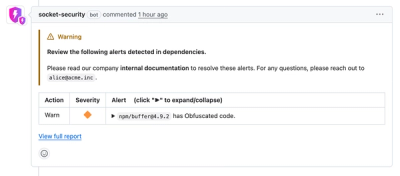
Security News
Crates.io Users Targeted by Phishing Emails
The Rust Security Response WG is warning of phishing emails from rustfoundation.dev targeting crates.io users.
supports-color
Advanced tools
The supports-color npm package is used to detect whether a terminal supports color and, if so, which kinds of color. It can be used to tailor output to the terminal's capabilities, avoiding the use of color when it's not supported and enabling it when possible. This can help improve the readability and aesthetics of command-line tool output.
Detecting Color Support
This feature allows you to check if the terminal supports color, and if so, what level of color support it has (basic colors, 256 colors, or 16 million colors).
const supportsColor = require('supports-color');
if (supportsColor.stdout) {
console.log('Terminal stdout supports color');
}
if (supportsColor.stdout.has256) {
console.log('Terminal stdout supports 256 colors');
}
if (supportsColor.stderr.has16m) {
console.log('Terminal stderr supports 16 million colors (truecolor)');
}Forcing Color Support
This feature allows you to force color support in the terminal. This can be useful for testing or when running in environments where color support is not detected correctly.
const supportsColor = require('supports-color');
process.env.FORCE_COLOR = '1';
supportsColor.stdout.level = 1;
console.log('Forced color support level to basic colors');Chalk is a popular npm package that allows you to style and colorize text in the terminal. It is more feature-rich than supports-color, providing an easy-to-use API for applying styles, but it also uses supports-color internally to determine color support.
ansi-colors is another npm package for coloring terminal text. It focuses on being lightweight and has no dependencies. It offers a similar API to chalk but does not have the same level of abstraction or convenience methods.
cli-color is an npm package that provides a function-based API for styling terminal text. It offers color support detection as well as a wide range of text formatting options. It is more comprehensive than supports-color but also more complex to use.
Detect whether a terminal supports color
npm install supports-color
import supportsColor from 'supports-color';
if (supportsColor.stdout) {
console.log('Terminal stdout supports color');
}
if (supportsColor.stdout.has256) {
console.log('Terminal stdout supports 256 colors');
}
if (supportsColor.stderr.has16m) {
console.log('Terminal stderr supports 16 million colors (truecolor)');
}
Returns an object with a stdout and stderr property for testing either streams. Each property is an Object, or false if color is not supported.
The stdout/stderr objects specifies a level of support for color through a .level property and a corresponding flag:
.level = 1 and .hasBasic = true: Basic color support (16 colors).level = 2 and .has256 = true: 256 color support.level = 3 and .has16m = true: Truecolor support (16 million colors)The package also exposes the named export createSupportColor function that takes an arbitrary write stream (for example, process.stdout) and an optional options object to (re-)evaluate color support for an arbitrary stream.
import {createSupportsColor} from 'supports-color';
const stdoutSupportsColor = createSupportsColor(process.stdout);
if (stdoutSupportsColor) {
console.log('Terminal stdout supports color');
}
// `stdoutSupportsColor` is the same as `supportsColor.stdout`
The options object supports a single boolean property sniffFlags. By default it is true, which instructs the detection to sniff process.argv for the multitude of --color flags (see Info below). If false, then process.argv is not considered when determining color support.
It obeys the --color and --no-color CLI flags.
For situations where using --color is not possible, use the environment variable FORCE_COLOR=1 (level 1), FORCE_COLOR=2 (level 2), or FORCE_COLOR=3 (level 3) to forcefully enable color, or FORCE_COLOR=0 to forcefully disable. The use of FORCE_COLOR overrides all other color support checks.
Explicit 256/Truecolor mode can be enabled using the --color=256 and --color=16m flags, respectively.
FAQs
Detect whether a terminal supports color
The npm package supports-color receives a total of 259,787,614 weekly downloads. As such, supports-color popularity was classified as popular.
We found that supports-color demonstrated a healthy version release cadence and project activity because the last version was released less than a year ago. It has 1 open source maintainer collaborating on the project.
Did you know?

Socket for GitHub automatically highlights issues in each pull request and monitors the health of all your open source dependencies. Discover the contents of your packages and block harmful activity before you install or update your dependencies.

Security News
The Rust Security Response WG is warning of phishing emails from rustfoundation.dev targeting crates.io users.

Product
Socket now lets you customize pull request alert headers, helping security teams share clear guidance right in PRs to speed reviews and reduce back-and-forth.

Product
Socket's Rust support is moving to Beta: all users can scan Cargo projects and generate SBOMs, including Cargo.toml-only crates, with Rust-aware supply chain checks.